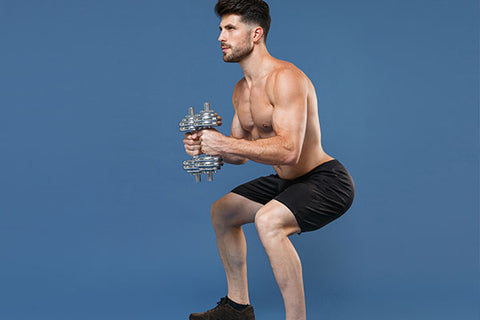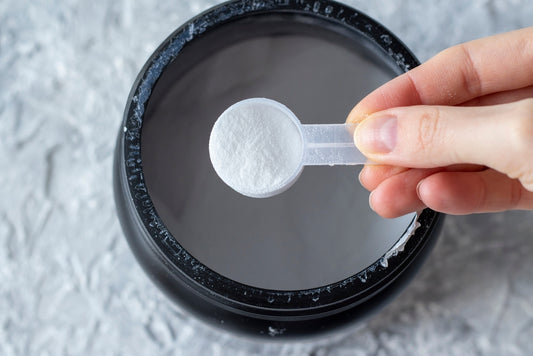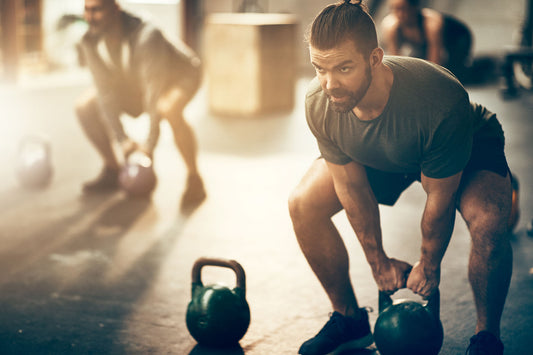Dumbbells are by far the most popular type of weights. They're affordable, they're easy to find and they're not intimidating for beginners. Dumbbells are also incredibly versatile, as they're commonly used in both simple beginners workouts and complex advanced routines. They're particularly useful for those with unevenly strong left and right sides as they're trained independently from each other.
If you're looking to start using dumbbells, or just want to change up your routine a bit, why don't you try out one of our favorite exercises below?
Lateral Raise
Which muscles? This exercise targets your shoulder muscles, particularly the lateral and anterior heads of the deltoid.
Why do it? Lateral raises don't require a ton of core strength, which makes it a good start for beginners. Besides aesthetic results, this exercise can help you balance out your left and right sides if one is stronger than the other.
How do you do it? Stand tall, holding a dumbbell in each hand. Keep your back straight and engage your core muscles. Raise your arms a couple inches to each side and pause. Then, slowly lift the weights to each side until your arms are parallel to the ground and your body is forming a T shape. Pause for a moment and then lower your arms slowly. Breathe in as you lift and breathe out as you lower the dumbells.

Lunge
Which muscles? Lunges work almost every muscle in your lower body — quads, hamstrings, glutes, hips, and calves.
Why do it? This classic exercise is a great addition to your workout as it works many muscles at once. Additionally, it stretches your hip flexor thus improving your flexibility.
How do you do it? Hold the dumbbells by your sides, take a big step forwards and lower your body until your knee is a few inches above the floor. Your thigh your be parallel to the ground, making a 90-degree angle with your calf. Your weight needs to be evenly distributed between both legs. Then, return to the starting position by pushing with the front leg.

Goblet Squat
Which muscles? This exercise works your quadriceps, biceps, shoulders, abs, spinal erectors, calves, and glutes
Why do it? The goblet squat is a full-body exercise that's great for improving cardiovascular health, building muscle, and improving hip and thoracic mobility. It's a good beginner's exercise that will help you improve your squat form. As a functional exercise, it mimics day-to-day movements. The more functional exercises you do, the more stamina and energy you'll have in your daily life.
How do you do it? Stand with your feet wide and toes angled slightly outwards, holding a dumbbell with both hands in front of your chest. Engage your core muscles and look straight ahead. Slowly sit down into a squat, keeping your chest tall and making sure that your weight is distributed evenly across your feet. Inhale as you go down and exhale as you go up.

Bench Press
Which muscles? Bench presses work your chest, triceps, and shoulders.
Why do it? This classic exercise is great for building upper body strength, doesn't require a lot of equipment and it's an easy great addition to your workout routine.
How do you do it? Lie on a flat workout bench while drawing your shoulder blades back. Make sure your feet are flat on the floor; if they don't use blocks or weight plates to support them. Slowly raise the dumbbells above your chest with your arms fully extended and slightly wider than your shoulders, palms facing towards your feet. Slowly lower the dumbbells by bending your elbows. Inhale as you lower the dumbells and exhale as you press them up.

Standing Dumbbell Calf Raise
Which muscles? This exercise targets the calves, specifically the gastrocnemius muscle.
Why do it? Calf muscles can be a bit tricky to incorporate into a workout, so an exercise like this is always a great bet. It's particularly good for runners and bikers, as the calves bear a lot of the impact in those sports, so calf strength is essential.
How do you do it? Stand up straight holding your dumbbells, then push down on your toes to raise your heels as high as you can. Keep your back straight and your core engaged. Then, slowly lower yourself down. Your heels need to drop lower than parallel but they should not touch the ground.

Bicep Curl
Which muscles? As the name suggests, this exercise targets the biceps. To a smaller extent, it also works the lower arm muscles.
Why do it? Beyond improving strength and aesthetics, this exercise can help you learn to use your arm muscles correctly. Simple daily activities such as picking things up can become much easier and less strenuous.
How do you do it? Stand up straight with your feet apart at hip-width. Hold one dumbbell in each hand, engage your core and keep your shoulders relaxed. Bend your arms and lift the dumbbells towards your shoulders, then lower your arms to a starting position. Go slow and be careful not to use momentum when you lift the weights.

Dumbbell Shoulder Press
Which muscles? This exercise targets the deltoid shoulder muscle.
Why do it? Besides working your shoulders and engaging your core muscles, this exercise can help you find out if you have a strength imbalance in your shoulders. An imbalance like this can affect your mobility and impair your movements.
How do you do it? Stand up with your back straight. Hold a dumbbell in each hand at shoulder height with your palms facing out. Slowly raise the weights above your head, and pause at the top. Then, lower them back down with a controlled motion.

Dumbbell Pullover
Which muscles? This exercise builds your chest, core, and back muscles, as well as your triceps.
Why do it? Dumbbell pullovers will help open up your chest and increase flexibility in your upper body. These areas can easily become tightened, especially among office workers and people with a sedentary lifestyle.
How do you do it? Sit on the end of an exercise bench. Plant your feet in the ground, slightly wider than the bench, and make sure that your back and neck are fully supported. Hold a dumbbell with each hand with your palms facing each other and slowly extend your arms upwards. Keep the weights over your head for a few seconds and then slowly move your arms back down.





